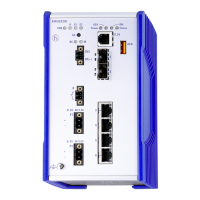Virtual Private Network > Connections
Virtual Private Network
236
RM GUI HiSecOS EAGLE20/30
Release
3.0
09/2015
Remote Identifier
Type
Specifies the type of remote peer identifier that the device uses for the
"Remote ID" parameter.
Possible values:
any
(default setting)
The device accepts every received remote identifier as unverified.
address
Use the local IP address or DNS name from the "Remote Endpoint" field
as the "Remote ID".
id
The device identifies the value specified in the "Remote ID" field as one
of the following types:
– An IPv4 address or a DNS host name
– A key identifier specifying data that the device uses to pass vendor-
specific information. The device uses the information to identify
which pre-shared key it uses for aggressive mode authentication
during negotiations.
– A Fully Qualified Domain Name (FQDN) web address, for example,
"foo.bar.com". Verify that the string does not contain any
terminators.
– An email address
– The ASN.1 X.500 Distinguished Name (DN) contained within the
"IKE Auth. Cert. Remote". The local and remote devices exchange
their certificates to establish the SA.
Remote ID Specifies the remote peer identifier which the device compares with the
value in the ID payload during phase 1 negotiations. The device uses the ID
payload to identify the initiator of the security association. The responder
uses identity to determine the correct host system policy requirement for the
security association.
The formats for this parameter depend on the type selected in "Remote
Identifier Type".
Possible values:
blank
When you specify "Remote Identifier Type" as
id
, then the following
values are possible;
– An valid IPv4 address or DNS host name
– A previously dspecified key identifier, specifying data that the
device uses to pass vendor-specific information
– A FQDN web address, for example, "foo.bar.com". Verify that the
string is without any terminators
– A valid email address
– A typical X.500 distinguished name
Use the following syntax when creating the entry:
CN=XY-D,C=DE,L=NT,ST=BW, O=COMPANY,OU=DEV,
E=testuser@company.com.
Parameters Meaning

